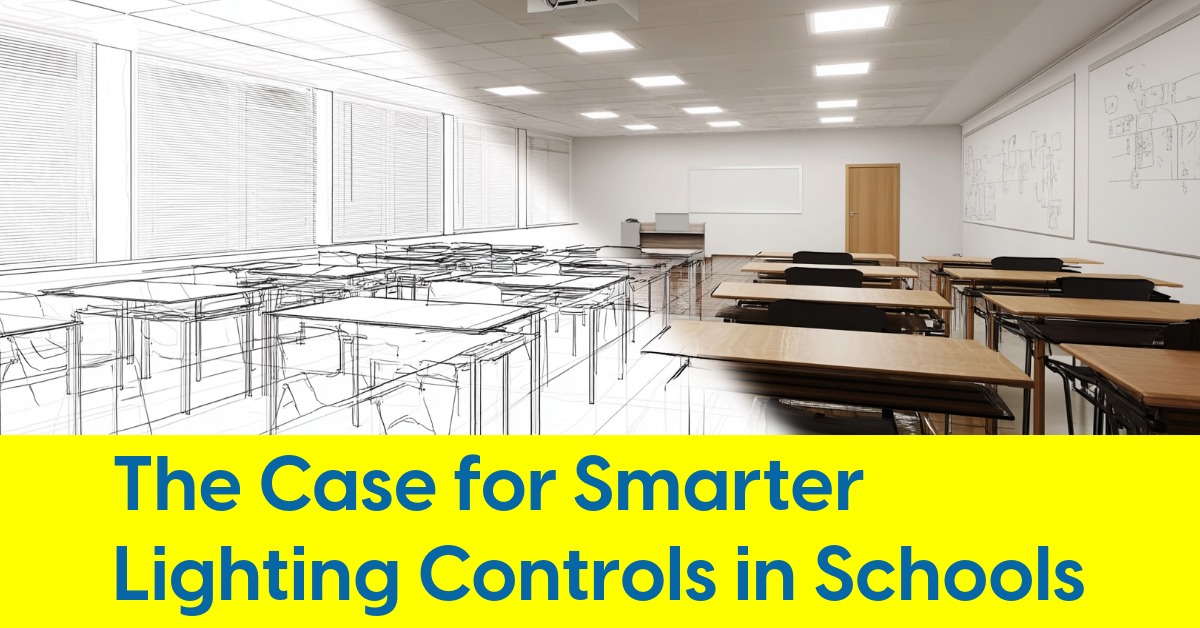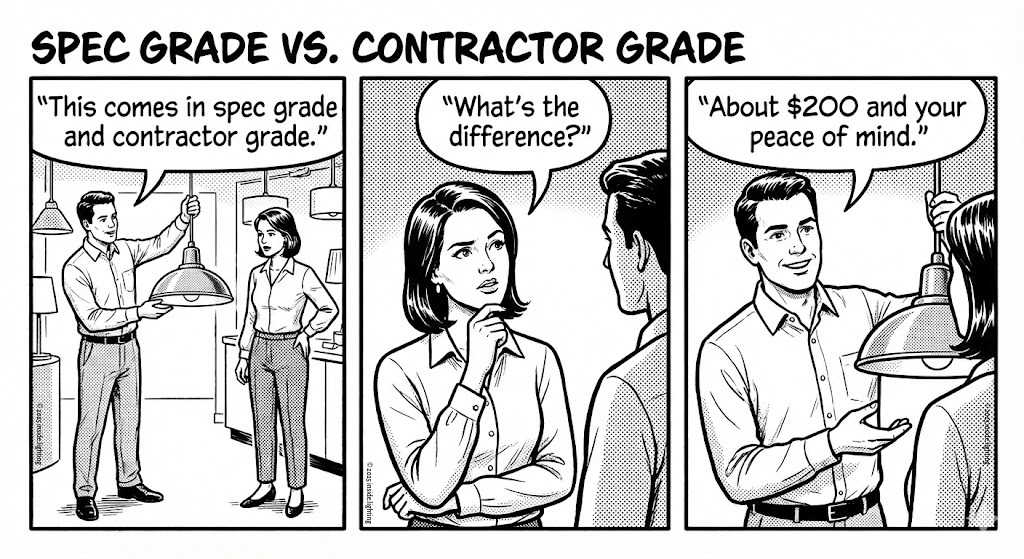October 1, 2025
The Case for Smarter Lighting Controls in Schools

Author: Craig DiLouie, LC, CLCP is education director for the Lighting Controls Association
Lighting upgrades unlock flexibility, comfort, and energy savings for modern classrooms
America’s schools lag behind all other commercial building types in adoption of LED lighting, according to the U.S. Department of Energy’s (DOE) latest Lighting Market Characterization report. To facilitate adoption, the DOE published Lighting Specification Guidance for Schools, a guide for school lighting upgrades, in November 2024. This comprehensive guide provides information on evaluating existing lighting, specifying an appropriate solution, and additional topics.
The primary legacy source for general lighting in most school spaces is fluorescent. These can be replaced by LED products for 20 to 60 percent energy savings, greater longevity, enhanced lighting quality, and controllability. The three main replacement options are tubular LED (TLED) lamps, retrofit kits, and new luminaires, each with its own advantages and disadvantages related to energy savings, cost, lighting quality, and accessibility of utility rebates.
A lighting upgrade is the ideal time to install lighting controls. Implementing controls such as dimming, automatic shutoff, and potentially color tuning can enhance savings, help condition the space to make it more conducive to learning, and provide flexibility in light levels and color. Type C TLED lamps, retrofit kits, and new luminaires all lend themselves to greater controllability, with the latter two options generally also offering the greatest ability to enhance lighting quality.
Evaluate the existing application. The first step in a school lighting upgrade project is to assess the existing lighting, spaces, and how the spaces are used, including floor plans and lighting layouts, if available, from construction documents and an onsite survey.
Generally, if the existing luminaires are older and/or in poor condition, retrofit kits or new luminaires will be worth considering as opposed to installation of Type C TLED lamps. If the fixtures are in generally good condition, Type C TLED lamps are also a potential solution. If dimming is desired for daylight control response and to enhance teacher control of the classroom, consider Type C TLED lamps, retrofit kits, and luminaires
Lighting quality is critical in lighting upgrades. For most building owners, the primary justification for upgrading legacy lighting systems to LED is to reduce operating costs by saving energy. Nonetheless, the lighting upgrade designer has a responsibility to maintain (or improve) lighting quality and to educate the owner about the benefits of lighting quality and refreshing the space appearance.
At a minimum, the proposed LED solution should avoid glare, flicker, poor uniformity, and low light levels. As such, the lighting specification should express the solution’s performance using accepted metrics.
These metrics begin with luminance (light output), measured in lumens, and resulting illuminance (light level) falling on the task surface, measured in footcandles or lux.
Many school spaces require uniformity of light level across the task surface, which is a function of both the light distribution of the luminaire and the spacing between luminaire. Softer and more diffuse illumination tends to be more visually comfortable as it minimizes glare.
The LED light source is rated with a correlated color temperature (CCT), which expresses the shade of white light, and color rendering index (CRI), which expresses its ability to render colors accurately compared to a reference light source (typically sunlight).
Design for lighting quality. Once the required lighting performance is determined, the proposed solution’s performance can be matched to the application’s existing conditions, project goals, and recommended practice as published by the Illuminating Engineering Society.
A few considerations for lighting quality include:
- Higher-quality LED drivers to minimize the potential for flicker.
- Properly shielding light sources and potentially dimming to minimize direct glare.
- Softer and more diffuse illumination for visual comfort and minimized glare.
- A consistent CCT in all interior spaces—typically 3000-4000K in education spaces and a specified CRI of 80+.
- For flexibility, tunable-white LED lighting, which provides a choice of shades of white light.
Overall, a mockup installation is recommended to evaluate products being considered before making a major commitment.
LED upgrades are an ideal time to consider lighting controls. Incorporating lighting controls into the project can extend flexibility, enhance lighting quality, and maximize energy savings and value.
If controls are not already installed, options include manual controls such as dimmers, tunable-white lighting, occupant- and daylight-responsive sensors and controls, and networked lighting controls. The DOE guide contains detailed recommendations for implementation.

Common lighting strategies in schools. Source: DOE
Schools are a prime opportunity for tunable-white lighting. Not all LED benefits have to do with energy savings. Among the features of LED lighting is the value-added ability to adjust color output in addition to intensity to support visual needs.
With legacy light sources, color is generally fixed after installation. In contrast, LED technology offers the potential for dynamic color output. By separately dimming LED arrays with different CCTs, a range of warm-to-cool shades of white light can be produced. If other colors are added to the arrays, saturated colors are also possible.
Why do this? Tunable-white lighting allows the CCT to be adjusted based on changing space use and user preference. In schools, teachers can cue students for activity changes and desired behaviors (e.g., quiet down or focus attention on the teacher).
To highlight this capability in schools, the DOE published a guide in January 2025. Why Tunable? A Look at Schools examines the impact of tunable-white LED lighting installed at eight school districts.
The DOE identified tunable-white LED installations at eight school districts across the U.S. between 2015 and 2023, representing both new construction and upgrades in existing buildings. The researchers were interested in why these schools opted to install tunable-white lighting, what features they chose, how the solutions were implemented, and finally what teachers thought about their new lighting. Findings included:
- Schools installed tunable-white for a range of reasons, notably to support teachers and students by providing the ability to visually (and gently) cue learning activities. Particularly useful for classrooms for students with special needs, where teachers need additional tools to cue desired behaviors.
- The schools installed varying solutions, with most providing a tunable CCT range of about 2700K to 6500K. CCTs controls were available through an interface as preset levels or in some cases, freely selectable. The types of interfaces also varied, including switches, buttons, sliders, touchscreens, and phone apps, with preset and/or programmable options as well as continuous dimming. In one project, interior lighting color was dynamically adjusted to align with the daylight cycle via a rooftop sensor.
- The DOE report stated teachers “responded positively to the tunable-white lighting systems in their classrooms, indicating the lighting improved the working and learning environment.” Overall, teachers found it an effective cuing tool, with a net gain in desired behaviors.
These field evaluations suggest that tunable-white lighting is a valuable tool for education, an upgrade option for existing LED adopters that extends beyond energy savings, and a potential point of engagement for converting a school to LED lighting.
Schools deserve energy-efficient, high-quality lighting. As children are the future, they and their educators need environments with lighting that enhances learning for the lowest operating cost. LED lighting that leverages its full capabilities, combined with lighting controls, should be considered for every project.
The Lighting Controls Association is a council of the National Electrical Manufacturers Association that provides education about lighting control technology and application, including articles, videos, design awards, news, resources, and Education Express, a free, 24/7 series of online courses covering everything from technology to design to commissioning.










